Inside vs. outside sales? They don’t need to operate in silos.
There’s a great debate taking place about Inside Sales vs Outside Sales. Is one method better than the other? If so, which one? There’s certainly no definitive answer because it depends on the person you’re talking to, their prior background, previous experience, and how they prefer to sell.
We’re going to let the cat out of the bag right now: inside sales isn’t any better than outside sales or vice versa. Both approaches can yield amazing results. The key is understanding the difference between the two so that you can choose the right one for your organization. So that’s what we’ll focus on today!
Keep reading to learn about inside and outside sales, how each can benefit your company, how to build teams in each medium, and more.
Inside Sales vs. Outside Sales: What’s the Difference?
You can’t settle the inside sales vs. outside sales debate for your company until you understand the main differences between these two approaches.
In this section, we’ll define what inside and outside sales are, as well as salary, sales cycle, job activities, popular tools, and necessary skill sets, for each.
What is Inside Sales?
Inside sales, sometimes referred to as remote sales, is the process of selling to customers from a distance. Inside sales reps typically work from a company office and use phones, emails, and other digital communication channels to close deals.
The organizations that tend to have the most success with an inside sales process are B2B brands, especially in the SaaS and tech industries.
What is Outside Sales?
Outside sales, AKA field sales, is the process of selling to customers via face-to-face correspondence. Outside sales reps spend a majority of their time traveling from customer to customer, away from their company’s headquarters.
Companies that employ field sales teams often sell expensive products and/or services.
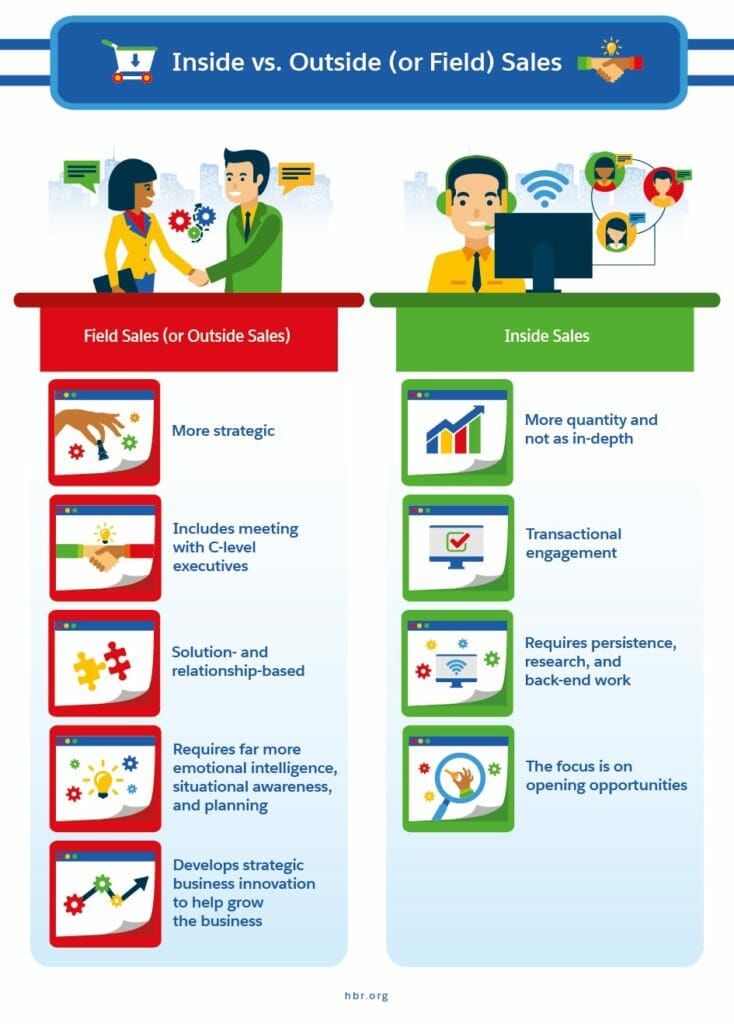
Salaries for Inside and Outside Sales Rep Salaries
What does it cost to hire an inside sales team? What about the cost to bring in a few outside sales reps? Let’s talk about typical salaries for inside vs. outside sales:
Inside sales rep salary
According to Glassdoor, the average inside sales salary in the United States is $44,791 a year. Payscale pins the figure a bit higher at $45,448 a year. Either way, expect to pay inside sales reps about $45k a year.
Outside sales rep salary
Referring back to Glassdoor, the average outside sales salary in the United States is $57,696 per year. But according to Payscale, the average salary is closer to $50k per year. Regardless, outside sales reps typically make more than inside ones.
Of course, the salaries mentioned above are just averages. If your company is located in a high-cost area such as San Francisco, you’ll likely need to pay more.
Sales cycles
One of the biggest differences between inside and outside sales is the complexity and length of the sales cycle. Let’s examine this in greater detail:
Inside sales cycles
The average inside sales rep deals with short sales cycles. In fact, it’s possible for an inside seller to go through an entire cycle, start to finish in as little as a few hours.
This is because most inside sales reps sell low-cost products. As such, their margins are quite slim, which means they don’t have time to spend multiple days on each lead. The goal is volume: more sales in less time equals success.
Outside sales cycles
Outside sales reps, on the other hand, are used to long sales cycles. Why? Because they typically sell high-cost products and services. To close these kinds of deals reps must build trusting relationships with prospects, which requires time.
Job activities
So what do inside and outside sales teams actually do on a regular basis? Each has a unique set of sales activities they need to complete to find success.
Inside sales activities
- Report to a company office and work consistent hours.
- Use the phone, emails, and other digital channels to engage prospects.
- Nurture leads by answering questions and displaying product knowledge.
- Close deals at a consistent clip in order to meet predetermined quotas.
- Catalog relevant sales data into a CRM and report to management.
Outside sales activities
- Connect with leads and schedule in-person meetings with them.
- Travel from prospect to prospect to meet prospects face-to-face.
- Stay in-touch with leads and nurture them through the sales cycle.
- Catalog relevant sales data into a CRM and report to management.
- Close high-value deals as often as possible and meet quota.
- Attend industry conferences, trade shows, and other events.
Toolkits
Inside and outside sales teams use different tools—mostly because they’re asked to complete different tasks, as we talked about in the previous section.
Outside sales teams need tools that can help them do things like build and manage territories, map routes, and monitor rep activity. For inside sales teams, auto-dialers and email tracking software are more pertinent.
Let’s take a closer look at the tools used by inside and outside sales teams:
Inside sales toolkit
- CRM Software: Customer relationship management software, better known as CRM software, is essential for inside sales reps. With this tool, sellers can catalog information about prospects, track their progress through the buyer’s journey, identify upsell and cross sell opportunities, and much more.
- Email Sequence Software: Most inside sales reps use email to connect with, qualify, and sell to prospects. The problem is, it takes a lot of time to send individual emails. Email sequence software allows reps to automate emails so that they can accomplish more sales activities in less time.
- Prospecting Tools: An inside sales rep is only as good as his or her leads. That’s why prospecting tools like LinkedIn Sales Navigator and UpLead are so important for inside BDRs. With these tools, inside reps can easily find potential buyers, connect with them, and pass information along to their CRM of choice.
- Wireless Headsets: A wireless headset might not be mandatory for inside sales reps, but it’s pretty close. Once an inside seller has one, they’ll be able to multitask much easier. For example, they’ll be able to take notes while they chat with prospects on the phone, boosting their productivity levels.
Outside sales toolkit
- Canvassing: Before outside sales reps can close deals, they have to meet prospects. As such, canvassing is an integral part of the sales process. Canvassing software makes it much easier to organize prospect information.
- Territory management: One outside sales rep can’t sell to all of your company’s customers. That’s why you need software to divide territories and give each to the most qualified rep. Doing so will increase team efficiency.
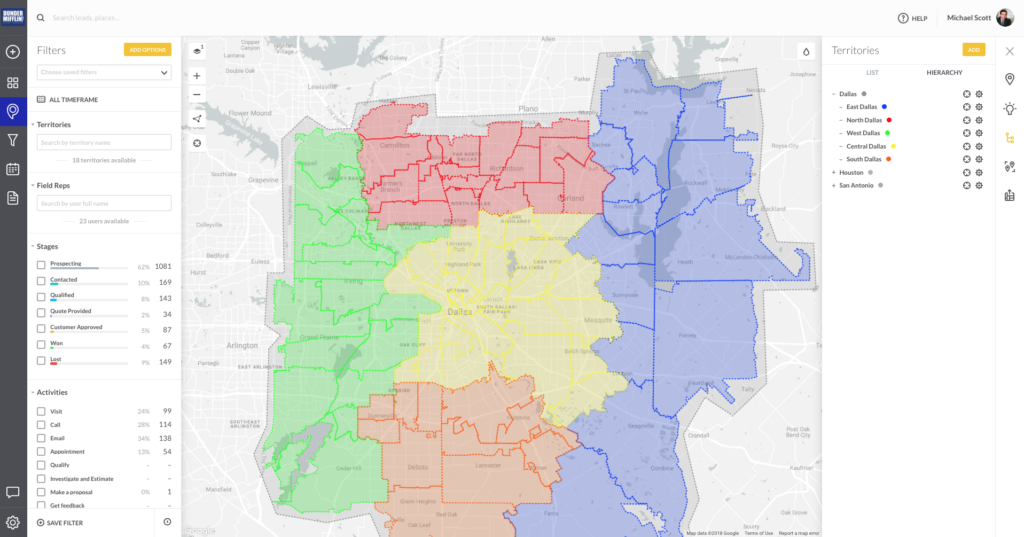
- Appointment setting: Outside reps are asked to regularly connect with potential customers in face to face scenarios. But before they can do that, they have to schedule their meetings in the most efficient ways possible. An appointment setting tool is essential in this regard.
- Route planning: Outside sales reps spend a lot of time traveling. A software tool that can identify the shortest route between customers and prospects will greatly increase rep productivity.
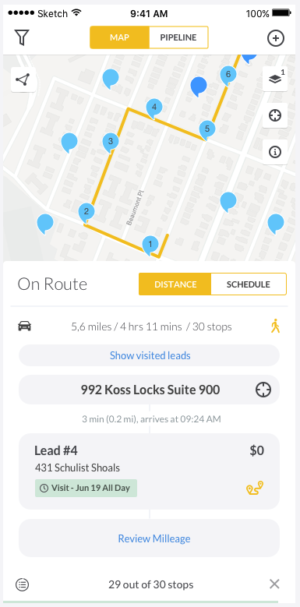
- Rep tracking: Is your outside sales team succeeding? Management needs tools to track their reps’ activities to answer this question; then use the information gleaned to increase sales performance.

- Customer mapping: Where are your customers located? How about your leads and qualified opportunities? When outside sales reps can see this information on a map, their job becomes much easier to do.
- Sales tracking: At the end of the day, sales are the only things that matter. As such, outside sales managers need to track and forecast sales for their teams, which is much easier to do with the right software tools.
Skill sets
Inside sales and outside sales may have a lot of similarities, and while they’re both still “sales,” there are some key differences that define a successful rep for each category, like inside reps understanding the importance of terminology.
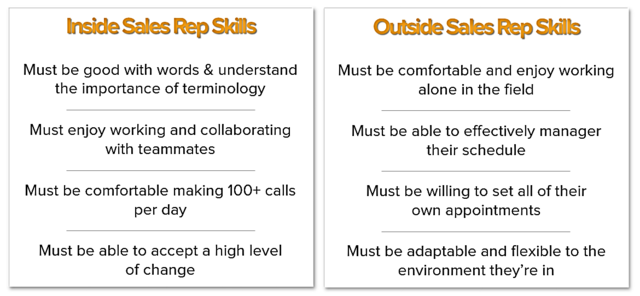
Sales models
While we’ve alluded to the different sales models for inside and outside sales teams, we haven’t fully described what each one looks like.
Inside sales model:
- Acquire qualified leads.
- Connect with potential buyers via digital channels.
- Typically close deals in 90 days or less. (Note: sales cycles can vary.)
- Spend less money on inside sales teams and scale with less effort.
Outside sales model:
- Travel from prospect to prospect.
- Nurture and convert potential buyers.
- Typically close deals in 90 days or more. (Note: sales cycles can vary.)
- Spend more money on outside sales teams and scale with greater effort.
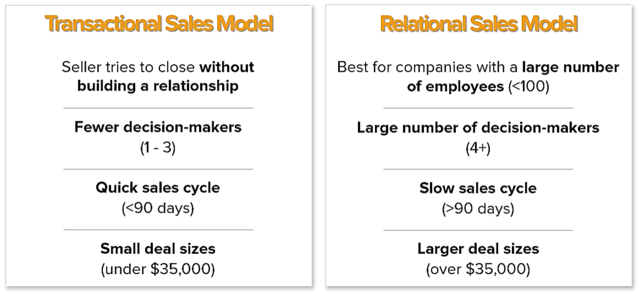
Geographies
Another key distinction in the inside vs outside sales debate has to do with geographies. In general, inside sales teams focus on selling to prospects in large territories. In fact, some inside sellers don’t focus on territories at all. They might sell to a customer in Oklahoma one week and a customer in London the next.
Outside sales teams, though, usually focus their efforts in very narrow territories. For example, an outside seller might spend all of their time in a single neighborhood, assuming said neighborhood has a collection of quality prospects.
Outside sellers typically work narrow territories because they travel from prospect to prospect. It would be extremely time consuming, not to mention expensive, for outside sellers to travel to different states and/or countries to meet with leads.
Close rates
What about close rates? Do inside or field sales reps close a higher percentage of deals? There are always outliers, of course, i.e. folks who buck common trends. But generally speaking, outside sales teams boast higher close rates.
This is because outside sales teams are adamant about finding and pursuing high quality leads. If they don’t, their entire sales strategy falls apart because it will take too much time and cost too much money to make a sale.
Inside sellers have more leeway. As such, they often focus on quantity because their margins are so thin. This lowers their close rate.
So, as you can see, while outside sales professionals have better close rates than inside sales reps, it’s not because they’re better at their jobs. It’s because they focus on more buy-ready leads, allowing them to convert a higher percentage of them into paying customers.
Metrics and KPIs
By now it should be pretty obvious: inside and outside sales are very different. Because of this, each sales team structure focuses on different activity-based and performance metrics.
Here are a few important metrics and KPIs for each:
Inside sales metrics
- Connect Rate
- Call Outcome
- Calls Per Hour
- Meetings Scheduled
- Deals Closed
- Forecast Accuracy
Outside sales metrics
- Sales Activities
- Leads Created
- Meetings Scheduled
- Logged Visits
- Deals Closed
- Referral Requests
- Attempted Upsells
Benefits of Inside Sales
As we’ve said multiple times in this article, when it comes to inside vs outside sales, one is not better than the other. They’re just different. As such, each sales strategy has different benefits. Here are a few benefits of inside sales:
- Greater speed: Inside sales professionals are able to respond to customers quicker. Why? Because they don’t have to travel to meet them. They just pick up the phone and give them a call, or type out a quick email.
- Fewer costs: Inside sellers make sales from inside a company office, which means they don’t have to worry about travel expenses. This fact allows inside sales teams to generate and convert leads for less money.
- Higher productivity: It’s a well-known fact that the average sales rep spends just 37% of their time selling. The number is even lower for most outside sales professionals because, once again, they have to travel to prospects. Windshield time is one of the biggest productivity killers for outside sellers.
Benefits of Outside Sales
What about outside sales? What are the benefits of this sales model? There are many. But we’ll focus on the top three:
- Stronger relationships: Because outside sales teams have face to face interactions with prospects, they’re able to build stronger relationships with customers and encourage greater loyalty from them.
- Higher close rates: Like we discussed in a previous section, outside sellers boast higher close rates than their inside counterparts. This is doubly beneficial because outside sales generally result in bigger deals, too!
- Easier to motivate reps: Lastly, it’s usually easier to motivate outside sales reps than it is to motivate inside ones. Why? Because almost all outside sales teams are paid commissions. Most people will work harder when they have money on the line. When inside sellers are only paid an annual salary, there isn’t as much incentive for them to go above and beyond the call of duty.
Inside and Outside Sales Statistics
We’ve given you a ton of information so far. How about we share a few cold, hard facts next? Here are 14 statistics about inside vs. outside sales:
- Inside sales teams are growing 15x faster than outside sales teams.
- An outside sales call costs $308, an inside sales call costs $50 (PointClear)
- 44% of inside sales pipeline comes from marketing, and inside sales average dials are down 20% year-over-year (Bridge Group Inc)
- 37% of high-growth companies use inside sales as primary sales strategy (vs. 27% for field sales, 23% for internet sales, 8% for channel sales) (Pacific Crest)
- Only 33% of inside sales rep time is spent actively selling. (CSO Insights)
- Sales reps can spend up to 40% of their time looking for somebody to call. (Inside Sales)
- Research shows that 35% to 50% of sales go to the vendor that responds first. (InsideSales.com)
- The average yearly quota for an inside sales professional is $985,000. (Harvard Business Review)
- Face to face or field sales teams make up 71.2% of the sales force.
- 65% of outside account executives attain quota, which is 10% higher than inside reps.
- Outside sales reps now spend 89% more time selling remotely than in 2013.
- Outside sales reps achieve an average 40% closing rate. (IHireSalesPeople)
- Following the COVID-19 pandemic, 27% of field sales teams were considering a shift from traditional field sales into virtual sales roles.
- The average yearly quota for outside sales reps is approximately $2.7M. (Harvard Business Review)
Structuring Inside and Outside Sales Teams
Are you interested in building inside and outside sales teams for your company? Then you should know that there are three ways to structure your department:
1. Split Your Inside and Outside Sales Teams
With this approach, your inside and outside sales teams will operate independently and each will have their own goals, leads, and quotas to hit.
The best part about this setup is that it enables each team to play to their strengths. The downside is that you’ll essentially have to run two separate departments: one for inside sales and one for outside sales.
2. Have Your Inside and Outside Sales teams Work Together
With this approach, your inside and outside sales teams will work together. Don’t worry, inside reps will still handle inside sales tasks and outside sales reps will handle outside sales tasks. But they won’t operate in silos.
Here’s an example: Your inside sales reps will connect with potential customers who live outside of the hundred mile radius that your outside sales reps work. When they find ready-to-buy prospects, they hand them off to outside sellers who then travel to the prospects place of business and attempt to close the deal.
3. Hire Hybrid Sales Reps to Complete Inside and Outside Sales
With hybrid sales, your sales reps will handle both inside and outside sales tasks.
What does this look like in the real world? When your reps are in the office, they make calls, send emails, etc. in an attempt to connect with prospects. On out-of-office days, your reps travel to their highest priority leads for in-person meetings, at which they do their best to close deals.
Inside Sales or Outside Sales: Which is better for your business?
It’s a tough decision to make. Both inside and outside sales approaches have pros and cons. To help you make the right choice, analyze the table below.
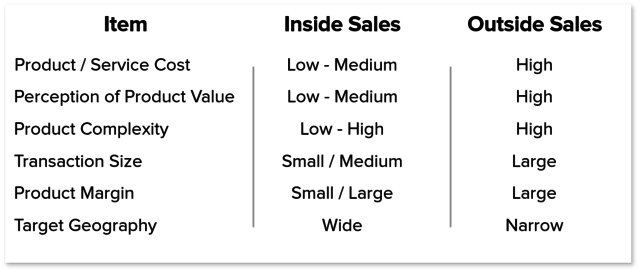
Have you decided to invest in outside sales? Then sign up for a free demo of SPOTIO. Our industry-leading sales engagement platform will help your team automate tedious tasks, split territories, connect with prospects on a variety of channels, track rep activities and company sales, and more.
________
SPOTIO is the #1 field sales engagement and territory management app to increase your revenue, maximize your profitability, and increase your team’s productivity in just 2 weeks.
Want to see a product demonstration? Click here to see how SPOTIO can take your sales game to the next level.


